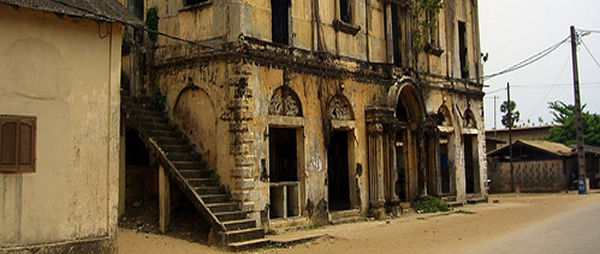Ivory Coast

Yet another oddity on the face of the African map is Ivory Coast. A nation, among the larger in the region, that has tended since the colonial period to be the pack leader among the West African Francophone states.
Ivory Coast, or Cote d’Ivoire, was at one time the virtual personal fiefdom of the iconic regional demagogue Felix Houphouët-Boigny, and remains the home of Afro/Reggae legend Alpha Blondy. Part of Felix Houphouët-BoignyÂs extravagant legacy is the Basilica of Our Lady of Peace in the ex-presidentÂs hometown of Yamoussoukro, an astonishingly sumptuous replica of the Vatican City’s Saint PeterÂs Basilica.
Ivory Coast has also had plenty of war, internal division and crisis, and as such is an honored member of the local neighborhood, but she is also probably the best developed nation in the entire region, and the one most generally appealing to the European temperament. The capital Abidjan is a tidy, well-appointed and attractive city with a fairly clean division between rich and poor. The aspect of downtown Abidjan is unmistakably African while uptown it is conspicuously well maintained and lavishly provisioned for an African city.
Inland an estimated 65 languages are spoken in a country predominately Roman Catholic, but with a powerful Muslim minority and strong adherence to traditional animist forms of life and worship. In a neighborhood of intense vivacity and color Ivory Coast lacks nothing, and is in fact a regional powerhouse of West African music, dance, arts and culture.
Travel To & Within Ivory Coast
Flights To Ivory Coast Hotels In Ivory Coast
Why Travel To Ivory Coast
Ivory Coast is a relatively large country, with the usual West African configuration of its head in the sub-Saharan Sahel region and its tail along the Atlantic Seaboard and the rich tropical belt of forest, coast and estuarine wetland. There are several very viable nature conservancies in the country, with the two principal UNESCO World Heritage Sites of Comoé National Park and Taï National Park being the most notable.
Taï National Park is perhaps the most important from a conservation point of view being that it is among the last remnants of primary tropical forest left in the entire region, and within it are listed a number of vulnerable species, including the Dwarf Hippopotamus and 11 species of monkey. The park lies adjacent to similar preserves in Liberia, both of which have in the past been threatened by illegal logging and other destructive economic practices.
Comoé National Park in the northeast of the country is an area of unique plant diversity in a riverine forest habitat that is isolated and something of a climatic oddity. It is one of the largest protected areas in West Africa.
Assagny National Park Banco National Park Comoé National Park Marahoué National Park Mont Nimba National Park Mont Péko Mont Sêngbé National Park Taï National Park
Ivory Coast is most notably a cultural destination, with a richly diverse ethnic identity and a correspondingly diverse assortment of cultures and languages. The region is a huge supplier of native artifacts to European collectors and general art pieces to the world market. Musically Ivory Coast is home to the famous talking drum and djembé styles as well as a wide range of local bands espousing afro and afro/reggae sounds. There are several cultural and music festival held annually in the country, including the Fête des Masques held in November in the region of Man.
Ivorian beach culture is not to be forgotten. The principal beach destination is the Grand Bassam situated east of Abidjan and comprising the faded glory of French colonial elegance with a more modern if occasionally ramshackle beach culture. Most upscale beach tourists look elsewhere for glamour and appeal but the Grand Bassam maintains its authentic allure. Needless to say almost the entire coast of Ivory Coast consists of one long, sandy beach, and the resort and accommodation option are comfortable, well established and legion.
When To Visit Ivory Coast
Ivory Coast is a popular European holiday destination so certain times of the year can be very busy, in particular between December and March, while the cool dry winter months between November and February are probably the optimum time to visit. The heaviest rain occurs between May and July, although thanks to the generally high standard of roads in the country year round travel is possible.
The ubiquitous local Harmattan winds can be a problem during December.
On the whole the Ivorian climate is hot and humid year round with the north tending to be drier and more arid.
Travel Warning
In recent years the relative tranquility of Ivory Coast was disrupted by civil war and widespread rebel activity. The country was divided more or less along the longitude of the town of Bouaké, so travel north of that point needs to be undertaken with caution since some insecurity persists as a result of the disarmament process. On the whole, however, the situation in the bulk of the country is stable.
There is a very limited threat of terrorism in Ivory Coast.
There are many guns in circulation in Ivory Coast, and in the main cities the risk of violent crime is high. Seek and take local advice in your movement around and within urban areas although in the more upscale section of Abidjan it is reasonably safe.
Beware of the ubiquitous West African scam artists who with great skill will part you from your coinage with at times severe financial loss. Treat every friendly encounter, expression of goodwill, invitation and unsolicited attention or offers of help with caution. Avoid any kind of street deal.
A high standard of health care is available in Ivory Coast. Malaria is a common problem and HIV/AIDS infection is widespread and so any risky sexual behavior is to be avoided.